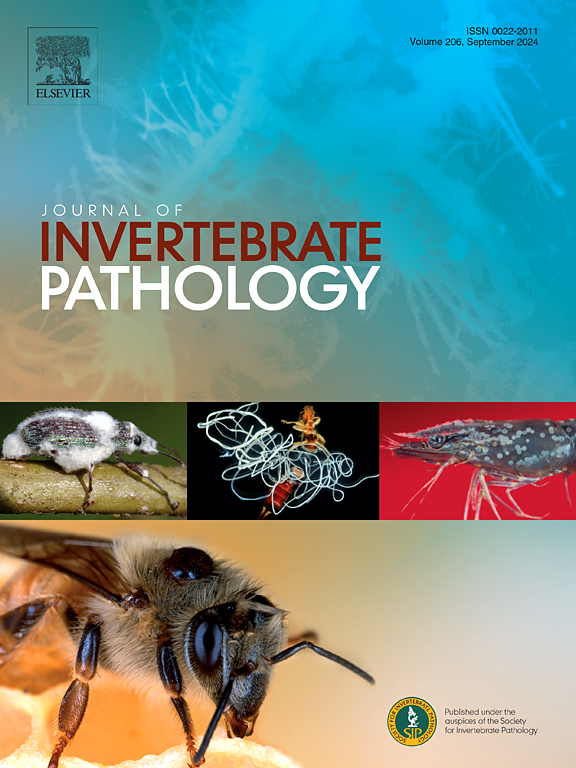Functional characterization of calreticulin in the antiviral response of Litopenaeus vannamei against white spot syndrome virus
IF 2.4
3区 生物学
Q1 ZOOLOGY
引用次数: 0
Abstract
Calreticulin (CRT) is a highly conserved calcium-binding protein that participates in various biological processes such as calcium homeostasis, molecular chaperoning, and immune function. In the present study, the complete cDNA sequence of CRT (LvCRT) was cloned and characterized from Litopenaeus vannamei. The deduced amino acid sequence of LvCRT contained two conserved CRT family signatures, three conserved repeated CRT family motifs, and an HDEL motif, a signature sequence for endoplasmic reticulum retention. The highest mRNA expression of LvCRT was detected in the hepatopancreas of healthy shrimp. When the shrimp were challenged with white spot syndrome virus (WSSV), significantly upregulated expression of LvCRT was detected at 24 h post-injection (hpi). The recombinant protein of LvCRT (rLvCRT) was produced, and its functions were characterized. It could induce agglutination of all tested microorganisms, especially Vibrio parahaemolyticus, which could be inhibited by lipopolysaccharide (LPS) and N-acetyl neuraminic acid (NeuNAc). rLvCRT could bind not only to saccharides on microbial surfaces but also to the recombinant protein of C-type lectin (CTL) containing a low-density lipoprotein receptor domain from Litopenaeus vannamei (rLvLdlr). The rLvCRT-rLvLdlr complex could interact with a recombinant protein of WSSV (rVP28), impairing WSSV infection. These findings confirm that LvCRT plays a role in shrimp immunity. LvCRT might cooperate with other CTLs in antiviral activity by binding to WSSV to prevent the penetration of WSSV into the host cells.

钙网蛋白在凡纳滨对虾抗白斑综合征病毒应答中的功能表征
钙网蛋白(Calreticulin, CRT)是一种高度保守的钙结合蛋白,参与多种生物过程,如钙稳态、分子陪伴和免疫功能。本研究从凡纳滨对虾(Litopenaeus vannamei)中克隆并鉴定了CRT (LvCRT)的完整cDNA序列。LvCRT的氨基酸序列包含两个保守的CRT家族特征序列,三个保守的重复CRT家族特征序列和一个内质网保留特征序列HDEL基序。正常对虾肝胰腺中LvCRT mRNA表达量最高。注射白斑综合征病毒(WSSV)后24 h, LvCRT的表达显著上调。制备了LvCRT重组蛋白(rLvCRT),并对其功能进行了表征。它能诱导所有被试微生物的凝集,特别是副溶血性弧菌,这种凝集可以被脂多糖(LPS)和n -乙酰神经氨酸(NeuNAc)抑制。rLvCRT不仅能与微生物表面的糖类结合,还能与含有南美滨对虾(Litopenaeus vannamei)低密度脂蛋白受体结构域的c型凝集素(CTL)重组蛋白结合。rLvCRT-rLvLdlr复合物可以与WSSV重组蛋白(rVP28)相互作用,削弱WSSV感染。这些发现证实了LvCRT在对虾免疫中起作用。LvCRT可能通过与WSSV结合,阻止WSSV侵入宿主细胞,从而与其他ctl协同发挥抗病毒活性。
本文章由计算机程序翻译,如有差异,请以英文原文为准。
求助全文
约1分钟内获得全文
求助全文
来源期刊
CiteScore
6.10
自引率
5.90%
发文量
94
审稿时长
1 months
期刊介绍:
The Journal of Invertebrate Pathology presents original research articles and notes on the induction and pathogenesis of diseases of invertebrates, including the suppression of diseases in beneficial species, and the use of diseases in controlling undesirable species. In addition, the journal publishes the results of physiological, morphological, genetic, immunological and ecological studies as related to the etiologic agents of diseases of invertebrates.
The Journal of Invertebrate Pathology is the adopted journal of the Society for Invertebrate Pathology, and is available to SIP members at a special reduced price.

 求助内容:
求助内容: 应助结果提醒方式:
应助结果提醒方式:


